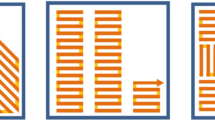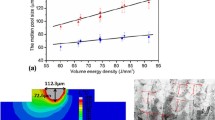Abstract
Selective laser melting (SLM) technology efficiently solves the current manufacturing challenges of high-performance porous structure components, due to its freeform fabrication principle. As the most basic and crucial structure element, the nodes of porous structure component play an important role in its mechanical property. In this study, finite element method was used to investigate the thermal behavior during SLM processing of micro-scale node-structure. The dynamic size of molten pool was continuously predicted and consequently the typical “necking” effect was found, which was consistent with the experiment results. Besides, the influence of laser scan speed on temperature and temperature gradient of molten pool was also analyzed. The results indicated that the “necking” effect became more conspicuous with the applied scan speed increasing, which significantly deteriorated the mechanical property of porous structure components.








Similar content being viewed by others
References
J. Čapek, M. Machová, M. Fousová, J. Kubásek, D. Vojtěch, J. Fojt, E. Jablonská, J. Lipov, and T. Ruml: Highly porous, low elastic modulus 316L stainless steel scaffold prepared by selective laser melting. Mater. Sci. Eng., C 69, 631 (2016).
P. Colombo, D.C. Dunand, and V. Kumar: Porous materials: Less is more. J. Mater. Res. 28, 2187 (2013).
S. Li, H. Hassanin, M.M. Attallah, N.J.E. Adkins, and K. Essa: The development of TiNi-based negative Poisson’s ratio structure using selective laser melting. Acta Mater. 105, 75 (2016).
V. Vendange and P. Colomban: How to tailor the porous structure of alumina and aluminosilicate gels and glasses. J. Mater. Res. 11, 518 (1996).
M. Leary, M. Mazur, J. Elambasseril, M. McMillan, T. Chirent, Y. Sun, M. Qian, M. Easton, and M. Brandt: Selective laser melting (SLM) of AlSi12Mg lattice structures. Mater. Des. 98, 344 (2016).
D. Wang, Y. Yang, R. Liu, D. Xiao, and J. Sun: Study on the designing rules and processability of porous structure based on selective laser melting (SLM). J. Mater. Process. Technol. 213, 1734 (2013).
M. Simonelli, Y.Y. Tse, and C. Tuck: The formation of alpha plus beta microstructure in as-fabricated selective laser melting of Ti–6Al–4V. J. Mater. Res. 29, 2028 (2014).
D.D. Gu: Laser Additive Manufacturing of High-performance Materials (Springer-Verlag, Berlin Heidelberg, 2015); pp. 175–198.
C. Ma, D. Gu, D. Dai, W. Chen, F. Chang, P. Yuan, and Y. Shen: Aluminum-based nanocomposites with hybrid reinforcements prepared by mechanical alloying and selective laser melting consolidation. J. Mater. Res. 30, 2816 (2015).
D.D. Gu: Materials creation adds new dimensions to 3D printing. Sci. Bull. 61, 1718 (2016).
I. Maskery, N.T. Aboulkhair, A.O. Aremu, C.J. Tuck, I.A. Ashcroft, R.D. Wildman, and R.J.M. Hague: A mechanical property evaluation of graded density Al–Si10–Mg lattice structures manufactured by selective laser melting. Mater. Sci. Eng., A 670, 264 (2016).
C. Haberland, M. Elahinia, J.M. Walker, H. Meier, and J. Frenzel: On the development of high quality NiTi shape memory and pseudoelastic parts by additive manufacturing. Smart Mater. Struct. 23, 104002 (2014).
Y.J. Liu, S.J. Li, H.L. Wang, W.T. Hou, Y.L. Hao, R. Yang, T.B. Sercombe, and L.C. Zhang: Microstructure, defects and mechanical behavior of beta-type titanium porous structures manufactured by electron beam melting and selective laser melting. Acta Mater. 113, 56 (2016).
B. Gorny, T. Niendorf, J. Lackmann, M. Thoene, T. Troester, and H.J. Maier: In situ characterization of the deformation and failure behavior of non-stochastic porous structures processed by selective laser melting. Mater. Sci. Eng., A 528, 7962 (2011).
A. Ostendorf, A. Neumeister, S. Dudziak, S. Passinger, and J. Stampfl: Micro- and Nano-parts Generated by Laser-based Solid Freeform Fabrication (Woodhead Publishing Limited, Cambridge, 2010); pp. 695–734.
P. Promoppatum, R. Onler, and S. Yao: Numerical and experimental investigations of micro and macrocharacteristics of direct metal laser sintered Ti–6Al–4V products. J. Mater. Process. Technol. 240, 262 (2017).
K. Dai and L. Shaw: Thermal and mechanical finite element modeling of laser forming from metal and ceramic powders. Acta Mater. 52, 69 (2004).
Y. Li and D. Gu: Thermal behavior during selective laser melting of commercially pure titanium powder: Numerical simulation and experimental study. Addit. Manuf. 1–4, 99 (2014).
C.H. Fu and Y.B. Guo: Three-dimensional temperature gradient mechanism in selective laser melting of Ti–6Al–4V. J. Manuf. Sci. Eng. 136, 061004 (2014).
D.Q. Zhang, Q.Z. Cai, J.H. Liu, and R.D. Li: A powder shrinkage model for describing real layer thickness during selective laser melting process. Adv. Mater. Res. 97–101, 3820 (2010).
J.P. Kruth, G. Levy, F. Klocke, and T.H.C. Childs: Consolidation phenomena in laser and powder-bed based layered manufacturing. CIRP Ann. Manuf. Technol. 56, 730 (2007).
ACKNOWLEDGMENTS
The authors gratefully acknowledge the financial support from the National Natural Science Foundation of China (Nos. 51575267), the National Key Research and Development Program “Additive Manufacturing and Laser Manufacturing” (No. 2016YFB1100101), the NSFC-DFG Sino-German Research Project (No. GZ 1217), the Key Research and Development Program of Jiangsu Provincial Department of Science and Technology of China (No. BE2016181), the Aeronautical Science Foundation of China (No. 2015ZE52051), the Top-Notch Young Talents Program of China, and the Priority Academic Program Development of Jiangsu Higher Education Institutions.
Author information
Authors and Affiliations
Corresponding author
Rights and permissions
About this article
Cite this article
Ma, C., Gu, D., Lin, K. et al. Thermal behavior and formation mechanism of a typical micro-scale node-structure during selective laser melting of Ti-based porous structure. Journal of Materials Research 32, 1506–1516 (2017). https://doi.org/10.1557/jmr.2017.112
Received:
Accepted:
Published:
Issue Date:
DOI: https://doi.org/10.1557/jmr.2017.112




